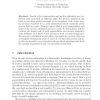Free Online Productivity Tools
i2Speak
i2Symbol
i2OCR
iTex2Img
iWeb2Print
iWeb2Shot
i2Type
iPdf2Split
iPdf2Merge
i2Bopomofo
i2Arabic
i2Style
i2Image
i2PDF
iLatex2Rtf
Sci2ools
IWCIA
2004
Springer
2004
Springer
Joint Non-rigid Motion Estimation and Segmentation
Abstract. Usually object segmentation and motion estimation are considered (and modelled) as different tasks. For motion estimation this leads to problems arising especially at the boundary of an object moving in front of another if e.g. prior assumptions about continuity of the motion field are made. Thus we expect that a good segmentation will improve the motion estimation and vice versa. To demonstrate this we consider the simple task of joint segmentation and motion estimation of an arbitrary (non-rigid) object moving in front of a still background. We propose a statistical model which represents the moving object as a triangular (hexagonal) mesh of pairs of corresponding points and introduce an provably correct iterative scheme, which simultaneously finds the optimal segmentation and corresponding motion field.
| Added | 02 Jul 2010 |
| Updated | 02 Jul 2010 |
| Type | Conference |
| Year | 2004 |
| Where | IWCIA |
| Authors | Boris Flach, Radim Sára |
Comments (0)

